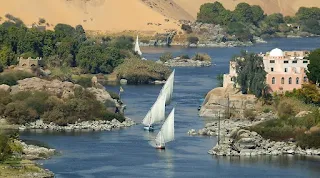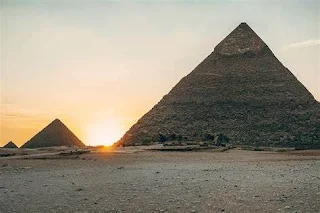What that Long Strip of Green Land in Egypt is Called
The 750-mile-long strip of green land that runs the length of Egypt is called the Nile River Valley.
The long green strip of land in Egypt is known as the Nile River Valley or simply the Nile Valley. It is a narrow fertile area that stretches alongside the Nile River, encompassing much of Egypt's land used for agriculture.
The Nile River, with its annual flooding, has provided the necessary water and fertile soil for agriculture, making the Nile Valley a vital region for the country's economy and civilization throughout history.
The strip of greenery stands out in contrast to the surrounding desert landscape and has been a lifeline for Egyptian civilization, supporting settlements, agriculture, and cultural development for thousands of years.
The Nile Valley is a vast geographical region that extends along the course of the Nile River, one of the longest rivers in the world. The length of the Nile Valley is approximately 1,200 kilometers or 750 miles from its starting point in the south to its delta in the north.
The Nile River originates from Lake Victoria in East Africa and flows through multiple countries, including Uganda, South Sudan, Sudan, and Egypt. As it passes through these countries, it carves out a fertile valley, known as the Nile Valley, which is characterized by its lush vegetation and arable land.
The length of the Nile Valley played a crucial role in Egyptian history.
In Egypt, the Nile Valley is particularly significant as it is home to the majority of the country's population and serves as the heartland of ancient Egyptian civilization. The river's annual flooding brought rich silt deposits that replenished the soil, making the Nile Valley ideal for agriculture. The ancient Egyptians relied on the Nile's waters for irrigation, allowing them to cultivate crops and sustain their society.
The length of the Nile Valley played a crucial role in the development and prosperity of ancient Egypt. The river provided a means of transportation and trade, facilitating communication and cultural exchange between different regions. It also served as a source of life and inspiration, with the ancient Egyptians considering the Nile as a deity and attributing its floods to the god Hapy.
Today, the Nile Valley remains a vital and densely populated region of Egypt, with cities, villages, and agricultural industries thriving along its course. Its length continues to shape the country's landscape, culture, and history, embodying the enduring significance of the Nile River in Egyptian civilization.
West Nile Valley is lush due to rain, meandering Nile deposits fertile soil.
The west side of the Nile Valley is more lush than the east because it receives more rain plus the Nile River is a meandering river and deposits fertile soil more on the west side.
The difference in the lushness of one side of the Nile Valley compared to the other is primarily due to the natural different forms and features of land surface and the distribution of water resources.
In Egypt, the Nile River flows from the south to the north, and the Nile Valley stretches alongside it. The eastern side of the Nile Valley, known as the Eastern Desert, is generally drier and less fertile compared to the western side, known as the Western Desert.
The reason for this contrast lies in the way the river interacts with the surrounding land. The Nile River has historically shifted its course over time, creating a natural phenomenon called a meandering river.
As the river meanders, it deposits silt and fertile soil along its banks, enriching the land with nutrients necessary for agriculture. This process has led to the development of a broader floodplain on the western side of the Nile Valley.
The Eastern Desert receives less rainfall compared to the Western Desert, which further contributes to the drier conditions on the eastern side. The western side, benefiting from the Nile's waters and a relatively higher amount of precipitation, experiences a more favorable climate for agriculture and supports a greater abundance of vegetation.
Building ancient civilizations on the lush Nile Valley's west side.
The lushness of the western side of the Nile Valley has made it more conducive to settlement and agriculture throughout history. Ancient Egyptian civilizations, such as the Pharaohs, primarily established their cities, temples, and agricultural fields on the western side due to the favorable conditions for cultivation.
These sites bear witness to the rich cultural heritage of Egypt and offer valuable insights into its ancient civilization. The west side of the Nile River Valley, with its fertile lands, historical significance, and natural beauty, plays a vital role in shaping Egypt's cultural and geographical identity.
It continues to be a region of immense importance, both in terms of agricultural productivity and the preservation of Egypt's rich history.
Wildlife on the West Side of the Nile River Valley
The west side of the Nile River Valley boasts a rich and diverse array of wildlife, showcasing the unique ecosystem of the region. From reptiles to birds and mammals, numerous animal species call this area home.
Nile crocodiles are a familiar sight in the Nile River and its surrounding waterways. Basking in the sun along the riverbanks or lurking beneath the water's surface, these large reptiles are skilled hunters, preying on fish and other small animals.
Venomous Egyptian cobras are prevalent in the Nile River Valley, including the west side. With its distinctive hood and potent venom, this snake species inhabits various habitats, including farmland and riverine areas.
Africa's largest lizard species, the Nile monitor lizard thrives along the banks of the Nile River. These impressive reptiles are adept swimmers and climbers, feeding on fish, birds, and small mammals.
Herons, egrets, ibises, and kingfishers can be observed wading in the water or perched on branches, hunting for fish and other aquatic prey on the west side of the Nile River Valley.
Although primarily found in the water bodies of the Nile, hippos also frequent the riverbanks. These massive herbivores spend their days submerged in water to keep cool and venture onto land at night to graze on grasses.
Along the fringes of the Nile River Valley, especially in the desert regions bordering the west side, various species of gazelles thrive. These agile antelopes have adapted to survive in arid conditions, foraging on sparse vegetation.









